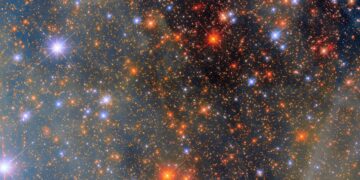The universe is filled with countless galaxies, each offering a unique window into cosmic evolution. Among the closest and most fascinating galaxies to our Milky Way is the Small Magellanic Cloud (SMC), a dwarf galaxy that has intrigued astronomers for centuries.
What is the Small Magellanic Cloud?
The Small Magellanic Cloud is a dwarf irregular galaxy located approximately 200,000 light-years away from Earth. It is part of the Local Group of galaxies, which includes the Milky Way, Andromeda, and the Large Magellanic Cloud (LMC). The SMC, though significantly smaller than the Milky Way, plays a crucial role in astronomical research. Due to its proximity, it provides an excellent laboratory for studying star formation and interstellar processes in an environment different from our own galaxy.
Visible to the naked eye from the Southern Hemisphere, the SMC appears as a faint, diffuse cloud in the night sky. Unlike the more structured spiral galaxies, the SMC has an irregular shape, which astronomers believe results from gravitational interactions with both the Milky Way and the LMC. These interactions have influenced its structure, triggering intense star-forming activity.
Hubble’s Latest Image: A Detailed Look
Hubble’s new image of the Small Magellanic Cloud captures an intricate scene of dust clouds, bright young stars, and dynamic interstellar activity. The image was taken using Hubble’s Wide Field Camera 3 (WFC3), which is designed to capture high-resolution images across a broad spectrum of light. To create this detailed view, astronomers combined data from four different filters, allowing for a multicolor representation of the region.
The image zooms in on a region near the center of NGC 346, a prominent star cluster within the SMC. NGC 346 is a stellar nursery, home to dozens of massive young stars. This area is of particular interest because it resembles the conditions of the early universe when galaxies were forming their first generations of stars.
Why is This Image Important?
Hubble’s observations of the Small Magellanic Cloud serve several scientific purposes. One of the most critical aspects of this image is its ability to study star formation in an environment with lower metallicity compared to the Milky Way. Metallicity refers to the abundance of elements heavier than hydrogen and helium. Since the SMC has a lower metallicity, it provides a glimpse into the conditions that existed in the early universe, where the first galaxies formed in a metal-poor environment.
Moreover, Hubble’s observations help astronomers study the distribution of dust clouds in the SMC. These clouds are essential for forming new stars, as they provide the raw material needed for stellar birth. Understanding how these clouds evolve and interact with existing stars can offer valuable insights into the life cycle of galaxies.
A Star-Forming Powerhouse
One of the most striking features of the Small Magellanic Cloud is its ability to produce stars at an accelerated rate. Observations suggest that interactions with the Milky Way and the Large Magellanic Cloud have triggered bursts of star formation in the SMC. This makes it an excellent case study for examining how galaxies evolve over time.
Hubble’s image of NGC 346 highlights a region where intense stellar activity is taking place. Young, hot stars illuminate the surrounding gas, creating stunning nebulae that glow brightly in ultraviolet and optical wavelengths. These massive stars will eventually explode as supernovae, enriching the interstellar medium with heavier elements that will, in turn, fuel the next generation of stars.
Comparing the Small Magellanic Cloud with the Milky Way
While the Milky Way is a large spiral galaxy with over 200 billion stars, the SMC contains only a few hundred million. Despite its smaller size, the SMC plays a crucial role in understanding galactic evolution. One of the key differences between the two is their metallicity levels. The Milky Way has undergone several generations of star formation, enriching its interstellar medium with elements like carbon, oxygen, and iron. The SMC, on the other hand, has a lower concentration of these elements, making it more similar to early galaxies that formed shortly after the Big Bang.
Another fundamental difference is their structures. While the Milky Way has a well-defined spiral shape with a central bulge and extended arms, the SMC lacks this structure due to its irregular nature. This irregularity is likely due to past gravitational interactions with other galaxies, which have disrupted its shape and triggered new waves of star formation.
The Role of Hubble in Understanding the Universe
Since its launch in 1990, the Hubble Space Telescope has revolutionized our understanding of the universe. Its ability to capture high-resolution images in multiple wavelengths has provided astronomers with invaluable data on galaxies, nebulae, and exoplanets. Hubble’s observations of the SMC are particularly significant because they allow scientists to study star formation in a different galactic environment.
Although Hubble will eventually be succeeded by the James Webb Space Telescope (JWST), its legacy will continue through its vast archive of images and data. The JWST, with its advanced infrared capabilities, will build upon Hubble’s findings and explore even deeper regions of the cosmos.
What’s Next for Studying the Small Magellanic Cloud?
While Hubble has provided remarkable insights into the SMC, future telescopes will continue to expand our knowledge. Upcoming missions, such as the Euclid Space Telescope and the Nancy Grace Roman Space Telescope, will offer more detailed surveys of nearby galaxies. These observations will help astronomers refine their models of galaxy formation and evolution.
Additionally, ground-based observatories equipped with adaptive optics, such as the European Extremely Large Telescope (E-ELT), will complement space-based observations by providing even higher-resolution images of the SMC.
Conclusion
The Small Magellanic Cloud is a cosmic treasure trove, offering invaluable insights into galaxy evolution, star formation, and interstellar interactions. Thanks to the Hubble Space Telescope, we now have a clearer view of its complex structure and dynamic stellar activity. These observations not only enhance our understanding of the SMC but also provide a historical window into the conditions of the early universe.



















